Composition Design and Performance Evaluation of Emulsified Asphalt Cold Recycled Mixtures
Abstract
:1. Introduction
2. Materials and Experiments
2.1. Raw Materials
2.2. Design of Emulsified Asphalt Cold Recycled Mixtures
2.3. Specimens Preparation and Experimental Methods
3. Performance Evaluation of Emulsified Asphalt Cold Recycled Mixtures
3.1. High-Temperature Stability
3.2. Water Stability
3.3. Fatigue Property
4. Influencing Factors of Fatigue Properties for Emulsified Asphalt Cold Recycled Mixtures
4.1. Effect of Humidity on Fatigue Life of Specimens
4.2. Effect of the Amount of Emulsified Asphalt on the Fatigue Life of Specimens
4.3. Effect of the Amount of Cement on the Fatigue Life of Specimens
4.4. Comparison with Other Materials
5. Summary and Conclusions
- (1)
- The composition design of emulsified asphalt cold recycled mixtures was carried out by the vibration forming method. The results show that the performance of the mixture with 65% RAP meets the requirements. The proportion of the design grading is: RAP materials: 0–3 mm aggregates: 10–20 mm aggregates: mineral powder = 65:13:20:2, the optimal emulsified asphalt binder and cement dosages were determined as 2.9 % and 1.5% respectively.
- (2)
- The developed emulsified asphalt meets the technical requirements and can be used in the composition design of cold recycled mixtures. The well-designed emulsified asphalt cold recycled mixtures have good high-temperature stability and water stability, which can meet the application requirements for a highway base and underlying layer.
- (3)
- When the stress level is lower, the fatigue performance of the mixture with low emulsified asphalt dosage is better; when the stress level is higher, the dosage of high emulsified asphalt is more favorable; when the stress level is lower, the fatigue performance under low cement content is better; but when the stress level is high, the cement content has little effect on the fatigue frequency.
- (4)
- Emulsified asphalt cold recycled mixtures have poor fatigue resistance and lower fatigue life than hot mix asphalt mixtures. Under the same stress level, the fatigue life of the hot mix asphalt mixture is higher than that of the recycled materials, and the sensitivity of recycled material to stress increase is greater than that of hot mix asphalt. Therefore, in structural design, the cold recycled structure layer should, as far as possible, not be placed in the bending-tension fatigue zone.
Author Contributions
Funding
Conflicts of Interest
References
- Chen, Y.H. Analysis of Mechanical Properties of Cement Stabilized Recycled Mixture. Road Mach. Constr. Mech. 2012, 9, 65–67. [Google Scholar]
- Zhao, G.J. Experimental study on factors affecting splitting strength of foamed asphalt recycled mixture. J. Zhengzhou Univ. Eng. Sci. 2012, 33, 72–75. [Google Scholar]
- Wu, X.R. Comparative analysis of crack resistance of different types of asphalt mixtures. J. Water Resour. Archit. Eng. 2016, 14, 28–131. [Google Scholar]
- Zhang, N.; Li, J.Y. Experimental study on water stability improvement of granite asphalt mixture. J. Water Resour. Archit. Eng. 2011, 9, 106–109. [Google Scholar]
- Liu, S.H. Analysis of Cold Regeneration Mechanism of Semi-rigid Base Asphalt Concrete Pavement. Highway 2011, 5, 192–196. [Google Scholar]
- Wang, Z.J. Improvement Mechanism of Cement on Microstructure of Emulsified Asphalt Mixture. J. Wuhan Univ. Technol. 2009, 31, 16–19. [Google Scholar]
- Zhang, D.L. Design of mixture mixing ratio for emulsified bitumen cold regenerated surface. Urban Roads Bridges Flood Control 2010, 16, 25–28. [Google Scholar]
- Sun, Y.S. Influence of Portland cement on the performance of emulsified asphalt cold regeneration. J. Wuhan Univ. Technol. 2013, 35, 45–48. (In Chinese) [Google Scholar]
- Bissada, A.F. Structural response of foamed-asphalt-sand mixtures in hot environments, Asphalt Materials and Mixtures. In Proceedings of the 66th Annual Meeting of the Transportation, Board, Transportation Research Board, Washington, DC, USA, 12–15 January 1987; pp. 134–149. [Google Scholar]
- Ebelsl, J. Characterisation of Material Properties and Behaviour of Cold Bituminous Mixtures for Road Pavements. Ph.D. Thesis, Stellenbosch University, Stellenbosch, South Africa, 2008. [Google Scholar]
- Yao, D. Research on cold recycled mixture fatigue performance. Highw. Eng. 2014, 39, 322–326. (In Chinese) [Google Scholar]
- Sravani, A.; Pramod, K.J.; Nagabhushana, M.N. Optimization of Recycled Asphalt Pavement in Cold Emulsified Mixtures by Mechanistic Characterization. J. Mat. Civ. Eng. 2015, 28, 04015132. [Google Scholar]
- Wu, C.F.; Zeng, M.L.; Zhao, M.H.; Zhong, M.W. Experimental study on road performance of emulsified asphalt cold recycled mixture. Highw. Traffic Technol. 2009, 26, 27–32. [Google Scholar]
- Du, S.W. Effect of additives on pavement performance of cold recycled asphalt emulsion mixture. J. Build. Mater. 2013, 16, 534–538. (In Chinese) [Google Scholar]
- Yan, J.H.; Ni, F.J.; Yang, M.K. Indirect tensile fatigue properties of asphalt emulsion cold recycled mixes. J. Build. Mater. 2011, 14, 58–61. (In Chinese) [Google Scholar]
- Guo, Y.C.; Shen, A.Q.; Zhang, M.C.; Sun, Z.Z.; Nie, C.K. Influencing factors of road performance of composite cold recycled base mixture of asphalt pavement. J. Highw. Transp. Res. Dev. 2014, 31, 32–38. (In Chinese) [Google Scholar]
- Wang, D.C.; Hao, P.W.; Wei, X.L. Fatigue performance and influence factor forcold recycling mixture with emulsified asphalt. J.Beijing Univ. Technol. 2016, 42, 541–546. (In Chinese) [Google Scholar]
- Jiang, Y.J.; Han, Z.Q. Effect of graded paired emulsified asphalt cold recycled asphalt mixture on road performance. J. Dalian Univ. Technol. 2018, 58, 607–614. [Google Scholar]
- Pouliot, N.; Marchand, J.; Pigeon, M. Hydrationmechanisms microstructure and mechanical properties of mortars prepared withmixed binder cement slurry-asphalt emulsion. J. Mater. Civ. Eng. 2003, 15, 54–58. [Google Scholar] [CrossRef]
- China Communications Publishing, JTG F40-2004. Specification for Construction Technology of Highway Asphalt Pavement; People Traffic Press: Beijing, China, 2004; ISBN 7114053282. (In Chinese) [Google Scholar]
- Li, J.; Zhang, J.; Qian, G.; Zheng, J.; Zhang, Y. Three-Dimensional Simulation of Aggregate and Asphalt Mixture Using Parameterized Shape and Size Gradation. J. Mater. Civ. Eng. 2019, 31, 04019004. [Google Scholar] [CrossRef]
- Jiang, Y.J.; Chen, Z.J.; Xu, X.H.; Liang, H. Evaluation on vertical vibration compaction method of ATB-30 asphalt mixture. J. Build. Mater. 2014, 17, 638–643. (In Chinese) [Google Scholar]
- Sheng, X.; Wang, M.; Xu, T.; Chen, J. Preparation properties and modification mechanism of polyurethane modified emulsified asphalt. Constr. Build. Mater. 2018, 189, 375–383. [Google Scholar] [CrossRef]
- Zhang, J.; Tan, H.; Pei, J.; Qu, T.; Liu, W. Evaluating crack resistance of asphalt mixture based on essential fracture energy and fracture toughness. Int. J. Geomech. 2019, 19, 06019005. [Google Scholar] [CrossRef]
- Zhang, H.B.; Guo, T.T.; Zheng, C. Study on properties of emulsified asphalt recycled mixture. Road Constr. Mach. Constr. Mech. 2014, 31, 69–71. [Google Scholar]
- Hou, S.; Chen, C.; Zhang, J.; Shen, H.; Gu, F. Thermal and mechanical evaluations of asphalt emulsions and mixtures for microsurfacing, Construction and Building Materials. Constr. Build. Mater. 2018, 191, 1221–1229. [Google Scholar] [CrossRef]
- Yang, F.Y.; Chen, W.F. Experimental study on road performance of cement stabilized recycled mixture. Highw. Eng. 2011, 36, 127–133. [Google Scholar]
- Yan, J.H.; Zhu, H.R.; Zhang, X. The theoretical analysis of the RAP aged asphalt influence on the performance of asphalt emulsion cold recycled mixes. Constr. Build. Mater. 2014, 71, 444–450. [Google Scholar] [CrossRef]
- China Communications Publishing, JTG F41-2008. Technical Specification for Asphalt Pavement Regeneration of Highway; People Traffic Press: Beijing, China, 2008; ISBN 9787114071058. (In Chinese) [Google Scholar]
- Zhang, J.; Li, X.; Liu, G.; Pei, J. Effects of material characteristics on asphalt and filler interaction ability. Int. J. Pavement Eng. 2019, 20, 928–937. [Google Scholar] [CrossRef]
- Pi, Y.H. Research on Materials and Structure of Emulsified Asphalt Cold Recycling for Asphalt Pavement with Semi-rigid base; School of Transportation Southeast University Press: Dhaka, Bangladesh, 2014. [Google Scholar]
- Dong, Z.J.; Tan, Y.Q.; Cao, L.P. Research on Indoor Design and Performance Evaluation of Cold Recycled Mixture with Emulsified Asphalt. J. Highw. Transp. Res. Dev. 2006, 23, 43–47. (In Chinese) [Google Scholar]
- Zhang, J.; Peng, J.; Zheng, J.; Dai, L.; Yao, Y. Prediction of Resilient Modulus of Compacted Cohesive Soils in South China. Int. J. Geomech. 2011, 36, 127–133. [Google Scholar] [CrossRef]
- He, D.P.; Jin, H. Study on Mixture Ratio Design Method of Cement Emulsified Asphalt Cold Recycled Mixture Based on Air Void. China Foreign Highw. 2016, 36, 284–288. [Google Scholar]
- Zhang, J.; Li, X.; Ma, W.; Pei, J. Characterizing heterogeneity of asphalt mixture based on aggregate particles movements. Iran. J. Sci. Technol. Trans. Civ. Eng. 2019, 43, 81–91. [Google Scholar] [CrossRef]
- Zeng, M.L.; Yu, Y.S.; Wu, C.F.; Huang, K.Y. The effect of cement on the performance of emulsified asphalt cold recycled asphalt mixture. Highw. Traffic Technol. 2008, 4, 59–62. [Google Scholar]
- Peng, Y.; Sun, L.J.; Shi, Y.J.; Huang, Z.Y. Influencing Factors of Splitting Strength of Asphalt Mixture. J. Jilin Univ.: Eng. Sci. 2007, 4, 1304–1307. [Google Scholar]
- Huang, X.M.; Zhang, J.P.; Liu, W.M. Prediction of Splitting Fatigue Life of Asphalt Mixture by Viscoelastic Theory. J. South China Univ. Technol. Nat. Sci. Edition 2008, 6, 56–61. [Google Scholar]
- Pi, Y.H.; Huang, X.M.; Liu, W.M. Fatigue Life Prediction of Asphalt Mixture Based on Splitting Creep. J. Wuhan Univ. Technol. Transp. Sci. Eng. 2009, 6, 1044–1047. [Google Scholar]
- Zhang, J.; Fan, Z.; Wang, H.; Sun, W.; Pei, J.; Wang, D. Prediction of dynamic modulus of asphalt mixture using micromechanical method with radial distribution functions. Mater. Struct. 2019, 52, 1–12. [Google Scholar] [CrossRef]
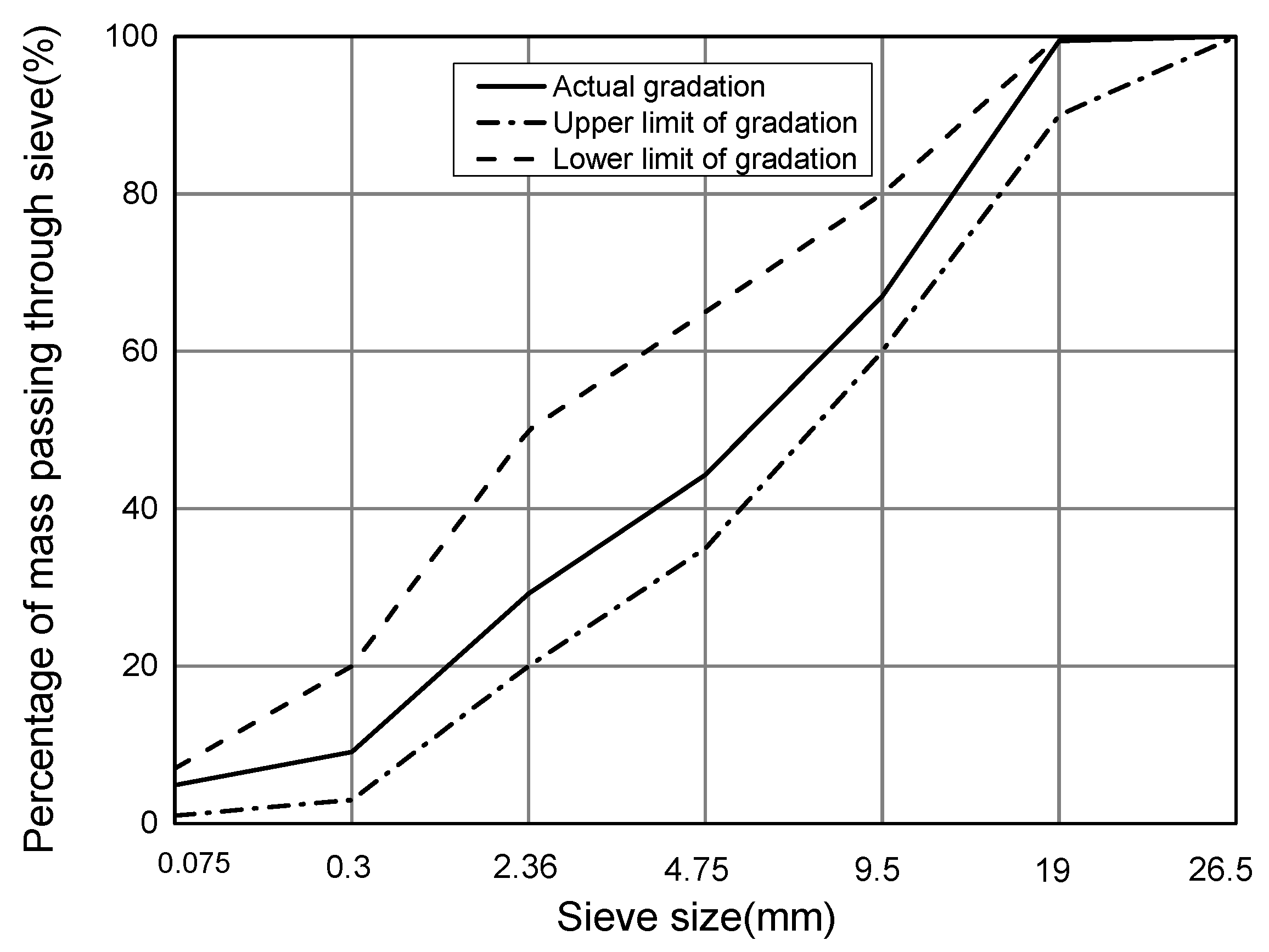
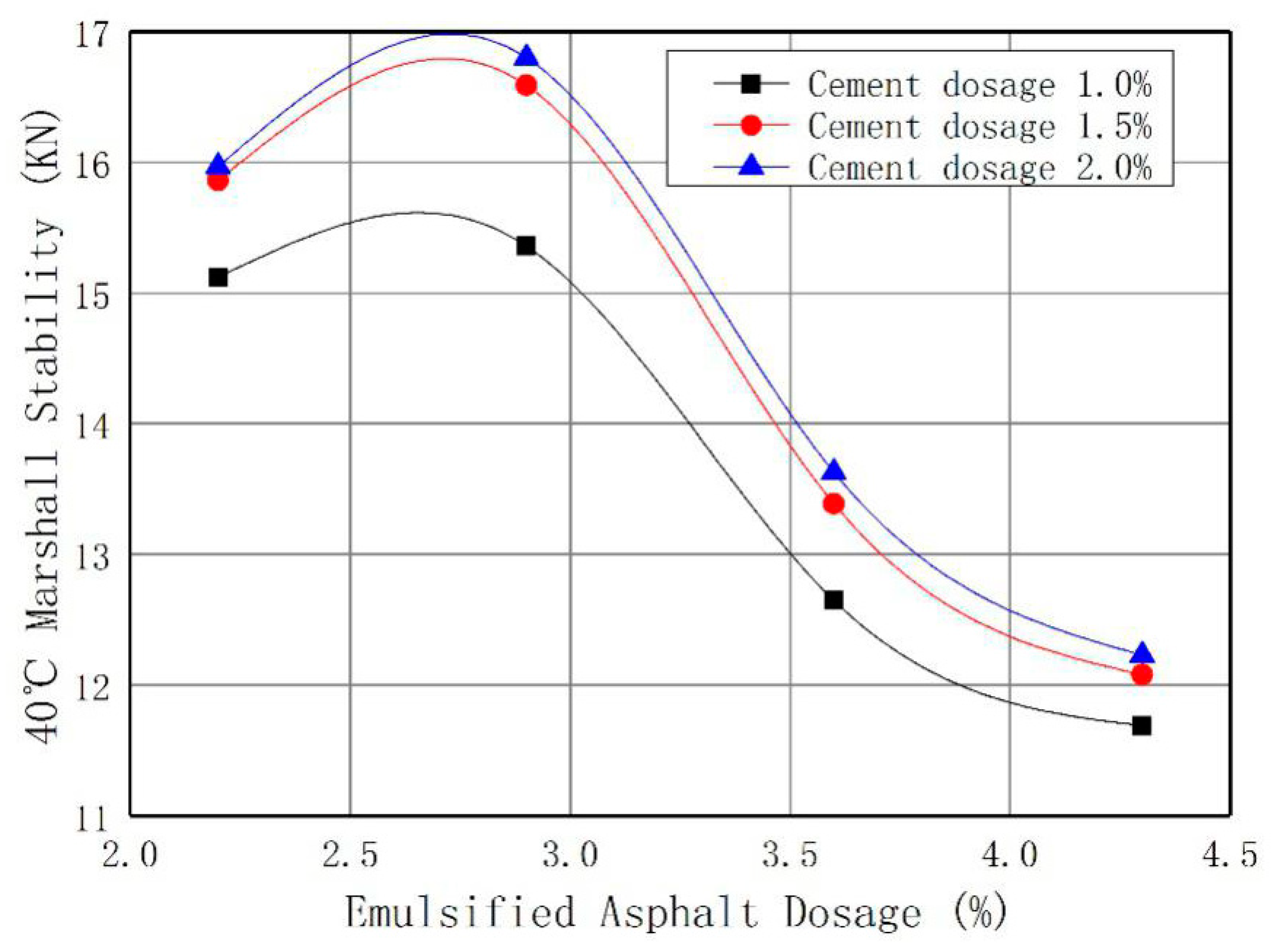

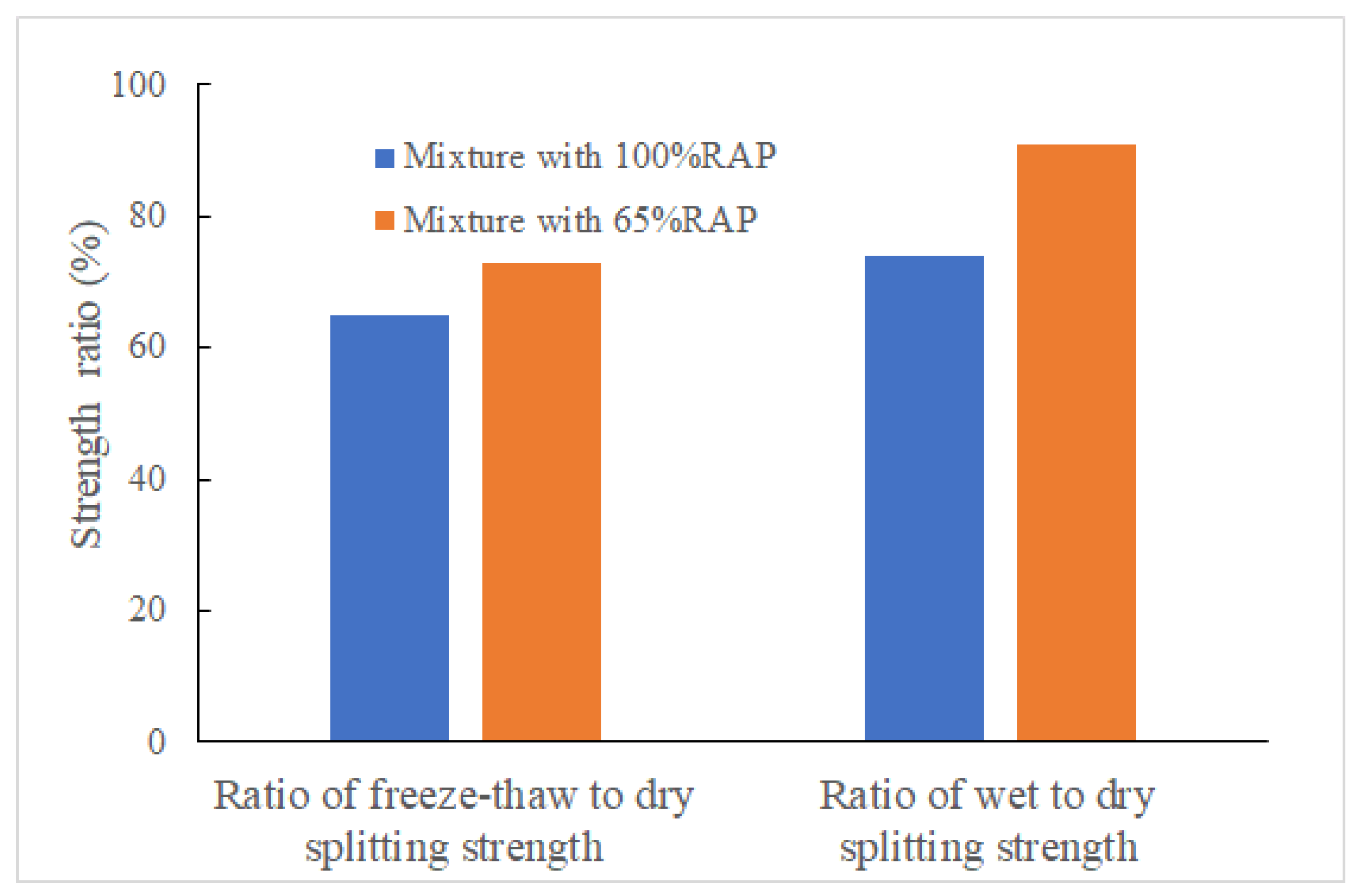
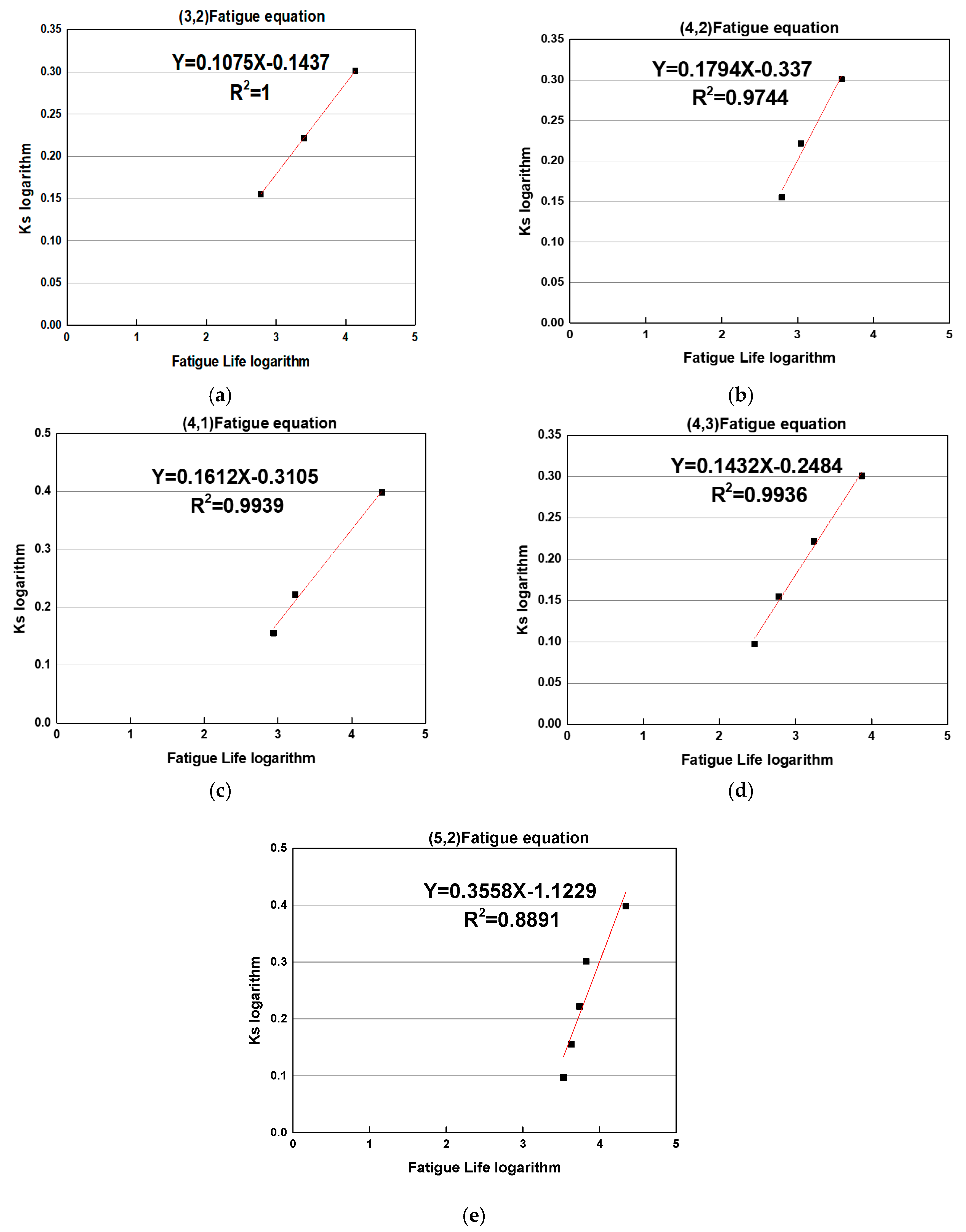

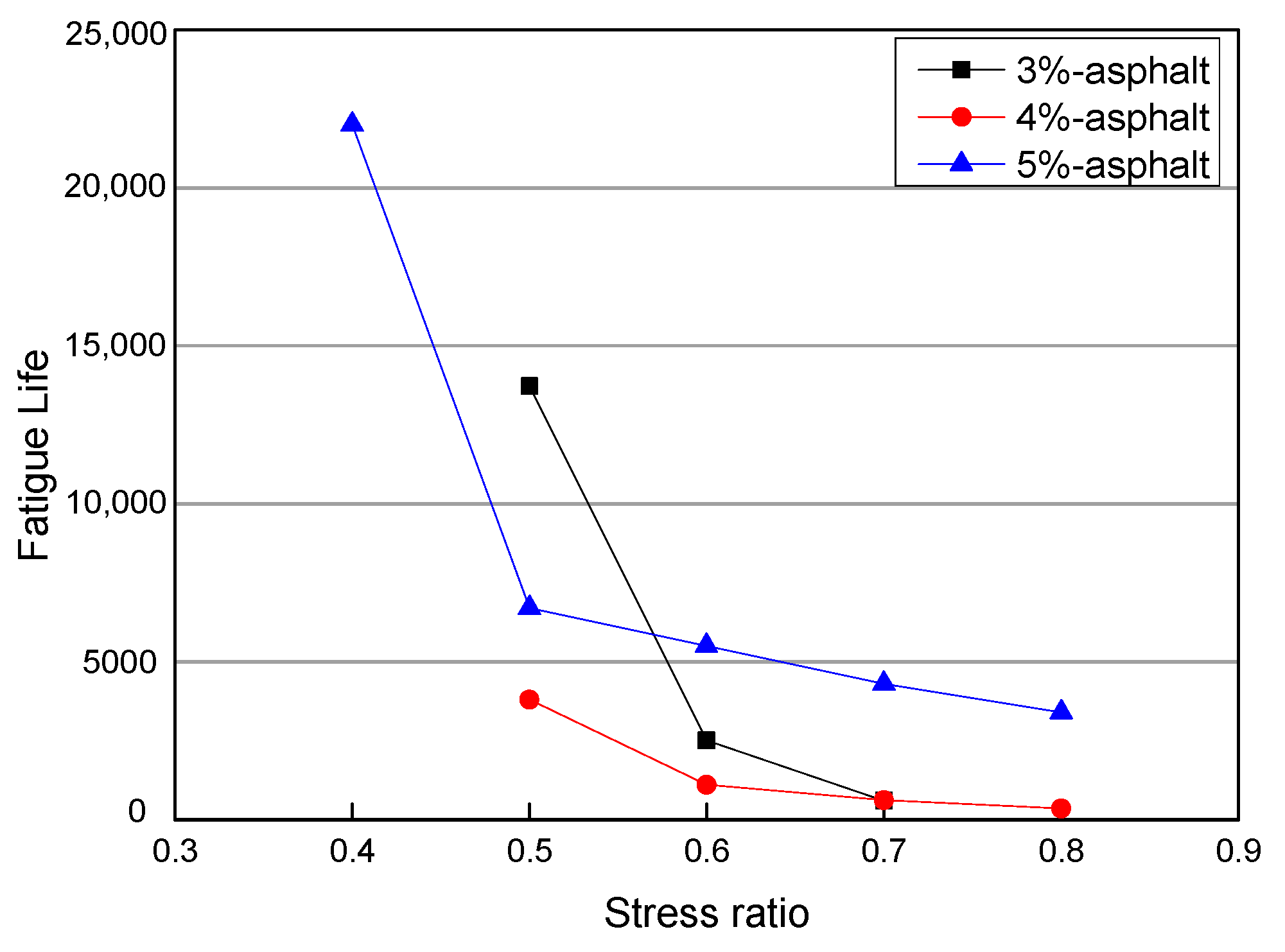



| Indexes | Test Results | Technical Requirements | Technical Method |
|---|---|---|---|
| Screen residual (1.18 mm), % | <0.1 | ≤0.1 | T0652 |
| Determination of Residue by Evaporation, % | 58.7 | ≥55 | T0651 |
| Demulsification Rate | Slow | Slow | T0658 |
| Charge | Cationic | Cationic | T0653 |
| Penetration (25 °C), 1/10mm | 88 | 45–150 | T0604 |
| Softening Point, °C | - | T0606 | |
| Ductility (15 °C), cm | 87.0 | ≥40 | T0605 |
| Storage Stability 5d | 3.5 | <5 | T0655 |
| Solubility (Trichloroethylene), % | 99 | >97.5 | T0607 |
| Standard Viscosity C25.3, s | 15.0 | 10–60 | T0621 |
| binding area | ≥4/5 | ≥4/5 |
| Indexes | Test Result | Technical Requirements | |
|---|---|---|---|
| Fineness (%) (0.08 mm square hole sieve residue) | 3.4 | ≤15 | |
| Initial setting time (min) | 180 | ≥45 | |
| Final setting time (min) | 360 | ≤390 | |
| Stability (boiling) | Qualified | Qualified required | |
| Compressive strength (MPa) | 3 days | 20.1 | ≥16 |
| 28 days | 48.8 | ≥42.5 | |
| Flexural strength (MPa) | 3 days | 4.6 | ≥3.4 |
| 28 days | 7.8 | ≥6.4 | |
| Sieve size/mm | 26.5 | 19 | 9.5 | 4.75 | 2.36 | 0.3 | 0.075 |
| Passing rate/% | 100 | 99.4 | 67.0 | 44.3 | 29.2 | 9.1 | 4.9 |
| Cement Content (%) | Emulsified Asphalt Content (%) | 15 °C Splitting Strength (MPa) | Technical Requirements (MPa) |
|---|---|---|---|
| 1.0 | 2.9 | 0.56 | ≥0.5 |
| 1.5 | 2.9 | 0.59 | |
| 2.0 | 2.9 | 0.61 |
| Grading Type | 45 min Deformation/mm | 60 min Deformation/mm | Dynamic Stability/Cycles·mm−1 |
|---|---|---|---|
| 100% RAP | 3.683 | 4.087 | 1560 |
| 65% RAP | 3.293 | 3.535 | 2157 |
| Mixtures Type | Dry Splitting Strength (MPa) | Freeze-Thaw Splitting Strength (MPa) | Wet Splitting Strength (MPa) |
|---|---|---|---|
| Mixture with 100%RAP | 0.23 | 0.15 | 0.17 |
| Mixture with 65%RAP | 0.45 | 0.33 | 0.41 |
| Asphalt Content (%) | Cement Content (%) | Splitting Strength (MPa) | Stress Ratio | Dry Splitting Fatigue Life | Wet Splitting Fatigue Life |
|---|---|---|---|---|---|
| 3 | 2 | 0.65 | 0.5 | 13,725 | |
| 0.6 | 2512 | ||||
| 0.7 | 600 | ||||
| 4 | 2 | 0.71 | 0.4 | 10,500 | |
| 0.5 | 3800 | 1500 | |||
| 0.6 | 1100 | 700 | |||
| 0.7 | 620 | 260 | |||
| 0.8 | 350 | ||||
| 5 | 2 | 0.62 | 0.4 | 22,000 | |
| 0.5 | 6700 | ||||
| 0.6 | 5500 | ||||
| 0.7 | 4300 | ||||
| 0.8 | 3400 | ||||
| 4 | 1 | 0.59 | 0.4 | 25,550 | |
| 4 | 3 | 0.80 | 0.5 | 7438 | |
| 0.6 | 1736 | ||||
| 0.7 | 600 | ||||
| 0.8 | 290 |
| Emulsified Asphalt and Cement Content | Linear Equation | Fatigue Equation |
|---|---|---|
| (3%, 2%) | y = 0.1075x − 0.1437 | |
| (4%, 2%) | y = 0.1794x − 0.337 | |
| (5%, 2%) | y = 0.3558x − 1.1229 | |
| (4%, 1%) | y = 0.1612x − 0.3105 | |
| (4%, 3%) | y = 0.1432x − 0.2484 |
© 2019 by the authors. Licensee MDPI, Basel, Switzerland. This article is an open access article distributed under the terms and conditions of the Creative Commons Attribution (CC BY) license (http://creativecommons.org/licenses/by/4.0/).
Share and Cite
Pi, Y.; Huang, Z.; Pi, Y.; Li, G.; Li, Y. Composition Design and Performance Evaluation of Emulsified Asphalt Cold Recycled Mixtures. Materials 2019, 12, 2682. https://doi.org/10.3390/ma12172682
Pi Y, Huang Z, Pi Y, Li G, Li Y. Composition Design and Performance Evaluation of Emulsified Asphalt Cold Recycled Mixtures. Materials. 2019; 12(17):2682. https://doi.org/10.3390/ma12172682
Chicago/Turabian StylePi, Yuhui, Zhe Huang, Yingxing Pi, Guangcan Li, and Yan Li. 2019. "Composition Design and Performance Evaluation of Emulsified Asphalt Cold Recycled Mixtures" Materials 12, no. 17: 2682. https://doi.org/10.3390/ma12172682





